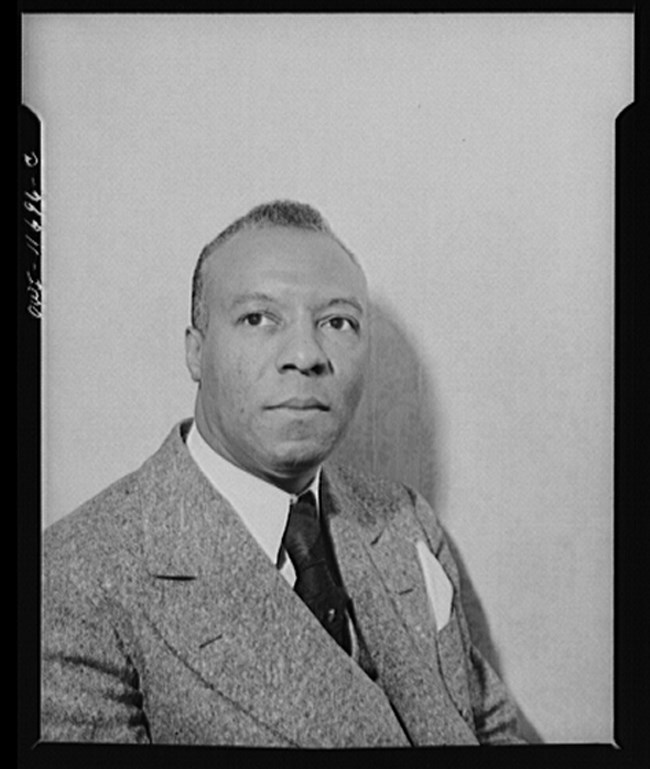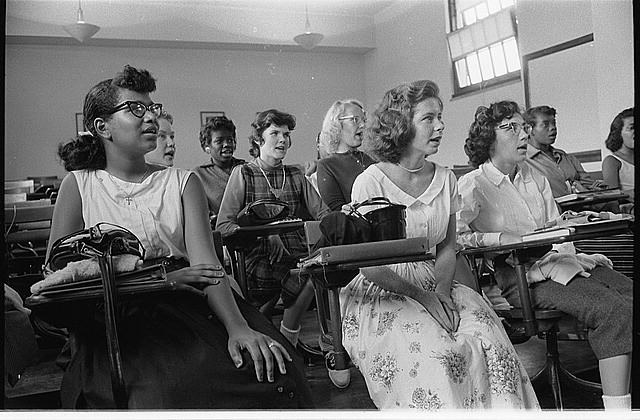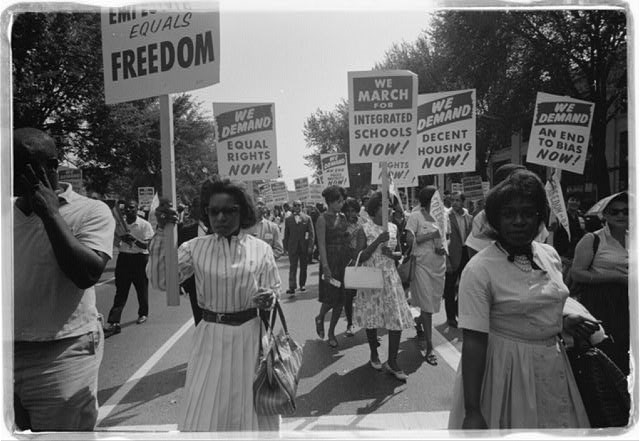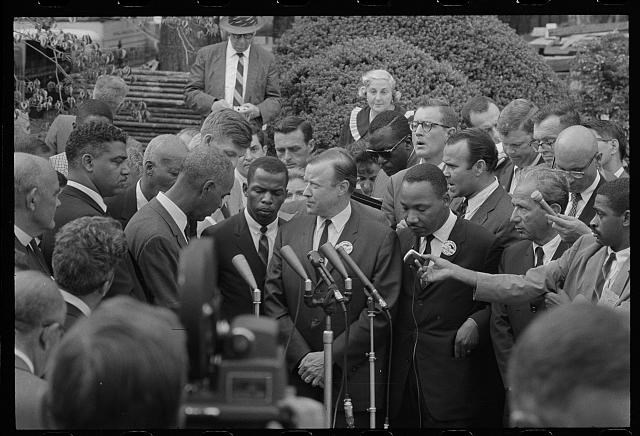Part of a series of articles titled A Timeline of Resistance: The Perseverance of African Americans from the Revolutionary War to the Civil Rights Era.
Article
The Modern Civil Rights Movement in the National Capital Area

Gordon Parks, Library of Congress.
The Rise of the Movement Timeline: 1942-54
The early decades of the 1900s saw the repression of equality in America with the rollback of Reconstruction era promises of an equal society for African Americans. It was as if Black people had only spent a summer weekend in freedom while the rest of the year kept them in chains. With the Plessy v. Ferguson (1896) court decision, the legal standard was to provide “separate but equal” resources and support, but this was far from what happened. White agitators held to their racist beliefs of Black people and influenced as much of society as they could. The physical separation of the races in public accommodations remained a resented and demeaning practice for those denied equal access. Segregation in theaters, restaurants, hotels, and buses was a constant irritant in everyday life and an insulting inconvenience. But this did not deter resistance to segregation- it continued to reinforce the resolve of civil rights activists as it had with abolitionists before the Emancipation Proclamation.
With the New Deal’s National Housing Act of 1934, local and state governments sponsored racially discriminatory lending policies that halted Black socioeconomic mobility. Drawing on racist beliefs surrounding African American abilities to pay on loans, “… Federal Housing Administration and Veterans Administration not only refused to insure mortgages for African Americans in designated white neighborhoods… they also would not insure mortgages for whites in a neighborhood where African Americans were present” (Rothstein 2017). Discrimination in loans was followed by redlining, an act of geographically mapping and limiting areas by race. Racially restrictive covenants, contracts designed to exclude African Americans from renting or buying a home in a White neighborhood, were used to reinforce segregation in the national capital area. Urban renewal and highway development threatened African American neighborhoods through displacement and economic uncertainty, redlining barred Black displaced residents from freely relocating throughout the city (Elder 2019). When James and Mary Hurd bought a home in Washington during the early 1940s, they did not know that it had a racial covenant in place. Their Bloomingdale White neighbors sued for their removal. When civil rights lawyer Charles Hamilton Houston took on the case, they were able to get it to the Supreme Court that had similar cases. While DC courts ruled against the Hurds, the Supreme Court ruled against the practice of racial covenants as unconstitutional in 1948. The course was set for change, as more African Americans and allies shifted their efforts to challenge segregation and discrimination in the coming Civil Rights Movement.
In the national capital area, things were changing. Under President Franklin D. Roosevelt, the defense industry was desegregated in 1942 when it entered World War II. For example, The Torpedo Factory in Alexandria, Virginia employed African Americans in positions originally filled exclusively by White Americans. In 1952, Leonard Muse, a Black pharmacy graduate from Howard University, opened the first Black pharmacy in Arlington County. In 1947, the number of students at Browne Junior High in Washington, DC was more than twice what the school could hold. They petitioned the DC School Board to move some Black students into the under-capacity White schools but were denied. The result would be a failed lawsuit against the School Board. But it would inform civil rights lawyers, activists and more parents to see the need to dismantle segregation in education altogether. In 1950, Burgundy Farm Country Day School achieved a milestone in the fight against segregation when it became the first integrated school in Virginia. The years between the 1940s and 50s saw victories that laid the way for the Modern Civil Rights Movement.
The detailed timeline below was written by Cheryl LaRoche et all and published in the NPS report Thematic Framework for the History of Civil Rights in the National Capital Area. Additions for this article include source references.
Timeline: 1941-54
1941 - Because of the District of Columbia’s unique system of federal oversight, many of Washington, DC’s recreational facilities were built and operated by the federal government. Eight public golf courses were owned and run by the federal government. While there were no laws prohibiting African Americans from playing these courses, the social customs of Jim Crow kept African Americans from fully enjoying most courses (Babin, 2017).
Three Black golfers took direct action by going to the East Potomac Golf Course and attempting to play. Though told they could not play on the White-only course, they returned later in the day with more Black golfers and played a game while being harassed by White attendees. Their intentions were not in vain, as Secretary of the Interior Harold Ickes heard of the incident and instructed that all golf courses be open to African Americans.
1942, 1944 - Ruth Powell, a student at Howard University, protested segregated downtown restaurants in Washington by occupying seats at diners that refused to serve Black customers. Other students joined Powell, and in 1944, she and two other Howard students were arrested. Law student Pauli Murray of the Howard branch of the NAACP undertook the legal fight, challenging the arrest of the students in court.
1943 - The “Double V” effort—Victory Abroad, Victory at Home—increased civil rights activity. In 1943 Howard University law student Pauli Murray led coeds in a sit-in at the Little Palace cafeteria, a white-trade-only business near 14th and U streets, NW, an area that was largely African American.
1943-44 - The Howard University chapter of the National Association for the Advancement of Colored People staged sit-ins at restaurants on U Street and in Penn Quarter.
1944 - The first March on Washington Monument occurred.
The first two African American housing cooperatives in the United States were formed in Arlington to purchase and protect war housing, George Washington Carver and Paul Laurence Dunbar.
1946 - The National Committee on Segregation in the Nation's Capital organized, seeking to bring nationwide attention to the shame of discrimination in the District of Columbia.
The Supreme Court delivered the Irene Morgan decision. Irene Morgan was a Black woman who had an interstate ticket on a bus. The Supreme Court ruled that she had been incorrectly arrested and punished, because if a person was moving between the states on a bus or train that had originated in the North, it was a burden on interstate commerce to stop the bus or train once it entered the South and waste time and energy separating people.
1947 - Three students of the Hoffman-Boston School in Arlington, formerly the Jefferson School, sued the city using the tactic employed by Charles Houston and Thurgood Marshall, arguing that the Black school was unequal to the facilities offered at the white school, Washington-Lee High School. Despite a favorable ruling by the circuit court, county schools remained essentially segregated until 1964.
The American Council on Human Rights was organized by the Alpha Kappa Alpha’s (AKA) local chapter. With the help of Delta Sigma Theta, Zeta Phi Beta, and Sigma Gamma Rho sororities as well as Alpha Phi Alpha, Phi Beta Sigma, and Kappa Alpha Psi fraternities, the organizations lobbied for the rights of American citizens. Between 1948 and 1963 the ACHR used their collective resources to make recommendations to the United States government pertaining to civil rights legislation. Representatives from each of the Black sororities and fraternities helped to strengthen the fight.
The Congress of Racial Equality (CORE) organized and launched a “Journey of Reconciliation” from Washington, DC throughout the upper South. This was a forerunner to the Freedom Rides that were to follow in the 1950s and 60s. An interracial group rode interstate buses to test the enforcement of the Supreme Court’s decision in Morgan v the Commonwealth of Virginia, which outlawed segregation and racial discrimination in interstate travel as unconstitutional.
1948 - Montgomery County, Maryland’s developers, such as Colonel Edward Brooke Lee, continued to enforce racial discrimination in their housing developments until the Supreme Court case Shelley v. Kraemer held that courts could not enforce racial covenants on real estate. Hurd v. Hodge and Urciolo v. Hodge were companion cases from the District of Columbia. The Court found that the Civil Rights Act of 1866 forbade restrictive covenants.
The National Committee on Segregation in the Nation’s Capital’s “Segregation in Washington” report was released. The report “drew national interest, helped spur government intervention and community organization against discrimination in many areas of D.C. society, and set the terms of debate under which the battle against school segregation in Washington DC would achieve success.”
Harry Truman issued Executive Order 9981, the desegregation of the Armed Forces.

Leffler, Warren K., Library of Congress.
The Archbishop of the Archdiocese of Washington ordered the desegregation of all Catholic parishes and schools.
Mary Church Terrell led a multiracial effort to end segregation in public accommodations through pickets, boycotts, and legal action. She either led or was involved in many of the pivotal moments in civil rights history in Washington, DC.
1949-1950 – Secretary of the Interior Julius A. Krug showed he was willing to enter an agreement with the Recreation Board to operate the District’s golf courses if they were willing to continue the Department’s policy of nondiscrimination and alter their bylaws to reflect the change (Babin, 2017).
The Anacostia Recreation Center, like other recreation facilities, was segregated in the 1940s. But when the NPS attempted to officially integrate the Anacostia Pool in June, African American children were harassed and chased away by angry Whites. After several days of similar conflicts, a more violent scuffle occurred on June 29, and the pool was closed for the summer. When it re-opened in 1950, it was a non-segregated pool.
1950 - Carr P. Cook, Jr., became the first Black to run for public office in Loudoun County, Virginia. He lost a seat for the Middleburg Town Council by two votes.
1951 - The Hecht Company stood at the southeast corner of Seventh and F Streets, NW, in DC. The city's oldest department store chain, and one of the most popular stores among African Americans during the era of segregation, refused to allow its many Black customers to eat in its cafeteria. In July 1951, the Coordinating Committee for the Enforcement of the D.C. Anti-Discrimination Laws (CCEAD), with Terrell at the helm, organized a protest against the store’s policies. The eighty-seven-year-old activist served as chair of the organization from 1949 to 1953 and joined its protesters. Protests against Kresge's, Hecht's, and Murphy's department stores all forced the stores to back down and desegregate their lunch counters. By January 1952, Hecht’s had changed its policies. The following year, on June 8, 1953, the CCEAD won the landmark Supreme Court decision — District of Columbia v. John Thompson. This ruling paved the way for Brown v Board of Education and nationwide school integration a year later.
1953 - After local courts upheld the 1872 and 1873 Civil Rights Acts as valid in the District, the Supreme Court affirmed these holdings in the District of Columbia v. John R. Thompson Co., ruling that segregation in Washington was unlawful based on the 1872 and 1873 laws passed during Reconstruction but long forgotten or ignored.
In February, President Dwight D. Eisenhower vowed, in his first State of the Union address, to end segregation in the capital.
The first two rural subdivisions in western Loudoun County, Aspen Hill and Leith Village, include covenants stating: “no part of the said property shall be sold, located, or occupied by any individual of African descent.”
1954 The Brown v. Board of Education ruling was issued by the US Supreme Court.
The Modern Civil Rights Movement Timeline: 1954-64
When it comes to the Civil Rights Movement, most people know about Martin Luther King Jr, Rosa Parks and other famous civil rights leaders, but it was not the efforts of a few people that brought change in the United States. The national capital area’s everyday people contributed to the overall success of the modern Civil Rights Movement. From students to pastors, lawyers to teachers, parents and every-day people planned efforts between the 1950s to the 1960s to eliminate segregation and the discrimination that came with it. While Washington DC served as a base for many civil rights efforts, the protests organized there reached out into the surrounding national capital area. When Samuel C. Murray and his wife Josie Murray were racially barred from the segregated Purcellville Library in Loudoun County, Virginia, they were able to get Washington lawyer Oliver Ellis Stone to take on their case. The result was the desegregation of the library and others under the county Board of Supervisors. The Student Nonviolent Coordinating Committee (SNCC), the Southern Christian Leadership Conference (SCLC), and the Congress of Racial Equality (CORE) were multiracial coalitions among many other civil rights groups that rose to the challenge. The National Association for the Advancement of Colored People (NAACP) saw the power of the everyday ordinary people, especially the youth, high school and college students.
They tackled segregation by openly challenging the status quo in every way possible. They sat in the front of buses and trains, refusing to give up their seat for White passengers’ demands. Students staged sit-ins at restaurants and lunch counters, subjecting themselves to insults, violence and arrest by police. They even challenged segregation at amusement parks such as Glen Echo Park. However, what made these days of civil disobedience different from the early twentieth century was the growing popularity of television, and its ability to show the message of protestors as they were hosed down in the streets by firemen, and bit by police dogs. But this did not persuade anyone to slow down. It only strengthened resolve, and in the year 1964, the Civil Rights Act of 1964 would be signed into law, making the sacrifices of many African Americans stretching back generations worth the long fight.
Information and the timeline are provided by Historic Resource Study: Reconstruction and the Early Civil Rights Movement in the National Capital Area and Thematic Framework for the History of Civil Rights in the National Capital Area by Cheryl LaRoche PhD, Patsy Fletcher, Caroline Spencer, and Lauren Hughes.
Timeline: 1954-64
1954 - The Fair Housing Act passed.
Charles Hamilton Houston served as the first lawyer for the Washington, DC school desegregation case that became Bolling v. Sharpe, which was a component of Brown v. Board of Education. The Supreme Court decision following the case encouraged the Recreation Board to formally remove its policy of segregation in recreation areas.
The 1954 case was part of the legal strategy to desegregate American schools and became a component of the landmark Brown v. Board of Education Supreme Court decision, which declared that separate education was unconstitutional.
The victory of the Supreme Court ruling in Brown v Board of Education reverberated across centuries of struggle. The constant push for quality education originated in the Sabbath Schools and universities of the Black church in response to anti-literacy laws and systematic segregation. Legal teams singled out public schools as the sites likely to yield effective results in their concerted efforts to desegregate the American education system.

Leffler, Warren K., Library of Congress.
Montgomery County adopted school integration plan for grades K-9.
1959 - Maryland ratified the Fourteenth Amendment, almost a century after its adoption.
1960 - On June 26, a group of activists met in Washington, DC, and formally organized the Nonviolent Action Group (NAG). It was decided that during the summer that the Glen Echo Amusement Park in Montgomery County, MD would be the next project for integration.
On August 15, over three hundred demonstrators assembled in Washington, DC, in the Capitol Rotunda, the White House, Congressional Houses, and the Democratic National Headquarters. Students participated from all over the South, including forty students who walked from Baltimore, Maryland.
1961 - In May, the first Freedom Ride was launched from Washington, DC by CORE to test the Supreme Court ruling outlawing segregation in bus and train terminals. Interracial groups of students entered segregated waiting rooms in bus terminals across the south. The bus was firebombed ten days later.
John Leighton Triggs and Norman Thomas from Howard University addressed 25,000 demonstrators at the Washington Monument and spoke about peace and the civil rights struggle.
On December 5, in the Boynton v. Virginia decision, the US Supreme Court overturned a conviction of Howard University law student Bruce Boynton for trespassing in a “whites only” restaurant in a bus terminal in Richmond, VA. Like many of the Freedom Rides, this one originated in Washington. Boynton had purchased his Trailways bus ticket and departed from the bus terminal at New York Avenue, bound for his home in Montgomery, AL. The ruling held racial segregation in bus terminals illegal, stating that such segregation violated the Interstate Commerce Act. The resulting ruling outlawed racial segregation in public transportation and contributed directly to the Freedom Riders movement.
The Student Nonviolent Coordinating Committee (SNCC) organized. The organization would later be influential in pushing for home rule for the District of Columbia.

Leffler, Warren K., Library of Congress.
1963 - On August 28, the March on Washington for Jobs and Freedom brought more than 250,000 people to the Lincoln Memorial with intention to pressure Congress to pass a civil rights bill. The event culminated at the Lincoln Memorial, where Dr. Martin Luther King, Jr. delivered his famous “I Have a Dream” speech.
Dumfries, in Prince William County, was the first municipality in Virginia to elect an African American to public office since the era of Reconstruction after the Civil War. Wilmer Porter, proprietor of a local auto repair business, was elected to the Dumfries Town Council.
1964 - President Lyndon Johnson signed the Civil Rights Act of 1964. It is considered the broadest legislation since Reconstruction and grants federal government the powers to enforce desegregation.
When the Civil Rights Act of 1964 was passed, it guaranteed federal protection under the law for all Americans. The act protected the right to vote; prohibited discrimination in public accommodations based on race, color, religion, or national origin; outlawed job discrimination based on race, color, religion, sex, or national origin; and gave the federal government broad authority in enforcing the federal on the state and local level. Civil rights acts passed over the remaining 1960s would attempt to essentially end discrimination in every facet of life. The journey from enslavement to emancipation, equality to civil rights had been long, but the transition into an integrated society would not be that simple. Progress would be slow, racism would continue to be a problem for Americans, and the impact of previous racist practices can still be seen today. But we can learn, grow and fight against the tide of oppression. The story of America continues to be written every day by people like you and me.
Works Cited
Babin PK. 2017. Links to the Past: A Historic Resource Study of National Park Service Golf Courses in the District of Columbia. National Park Service- National Capital Regional Office. National Capital Region, Washington, D.C.DataStore – (Links to the Past: A Historic Resource Study of National Park Service Gold Courses in the District of Columbia)
Elder E. 2019. Meridian Hill Park, African American Experiences Since the Civil War: A Special Resource Study. Historic Resource Study. National Park Service- National Capital Regional Office. National Capital Region, Washington, D.C.DataStore – (Meridian Hill Park, African American Experiences Since the Civil War)
LaRoche CJ, Fletcher P, Hughes L, Spencer C. 2021. Thematic Framework for the History of Civil Rights in the National Capital Area. NPS Special History Study. National Park Service. Washington, D.C. DataStore – (Thematic Framework for the History of Civil Rights in the National Capital Area)
Rothstein, R. 2017. The Color of Law: A Forgotten History of How Our Government Segregated America. Liveright. New York, NY.
Tags
- anacostia park
- birmingham civil rights national monument
- brown v. board of education national historical park
- freedom riders national monument
- george washington memorial parkway
- martin luther king, jr. memorial
- national mall and memorial parks
- potomac heritage national scenic trail
- the white house and president's park
- washington monument
- african american
- african american history
- civil rights
- civil rights act of 1964
- march on washington for jobs and freedom
- march on washington
- segregation
- desegregation
- desegregation of armed forces
- desegregation of public education
- black history
- ncr
- ncro
- national capital region
- history
Last updated: December 20, 2023
